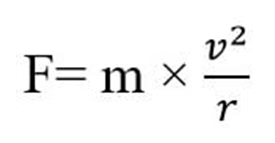Introduction to Centrifugal force and Centripetal force
When an object moves in a circular path, two important forces come into play — centripetal force and centrifugal force. Although they sound similar, these forces are opposites in direction and differ in nature.
- Centripetal force is a real force that pulls an object towards the center of its circular path.
- Centrifugal force is a fictitious (pseudo) force that seems to push an object outward, away from the center.
Both concepts are essential in understanding rotational motion in physics and have practical applications in biology, chemistry, engineering, space research, and daily life.
Centrifugal Force – Definition & Nature
- Definition: Centrifugal force is the outward, fictitious force that appears to act on a body moving in a circular path, directing it away from the center of rotation.
- Nature: It is not a real force in the Newtonian sense; it appears only when we observe motion from a rotating (non-inertial) reference frame.
- Direction: Always directed away from the center of rotation, parallel to the radius.
- Relation to Centripetal Force: It has the same magnitude but opposite direction to centripetal force.
Why Centrifugal Force is Called Fictitious?
- It doesn’t arise from a physical interaction.
- Exists only when centripetal force is acting.
- It is a result of an object’s inertia — the tendency to continue moving in a straight line even when the path is curved.
Factors Affecting Centrifugal Force
- Mass (m) of the object – Heavier objects experience greater force.
- Distance from the center (r) – Force increases with radius.
- Speed of rotation (v or ω) – Higher speed means greater force.
Centrifugal Force Formula
- Using Tangential Velocity

where v is the velocity of the moving body, r is the distance of the moving body from the center and m is the mass of the moving body.
- Using Angular Velocity

where ω is the angular velocity, r is the distance of the moving body from the center and m is the mass of the moving body.
Principle of Centrifugal Force
- When a car turns sharply, passengers feel like they are being pushed outward. This is because their bodies resist the change in direction (inertia), while the car changes direction due to centripetal force acting on it.
- In reality, no force is pushing them outward — it’s just their tendency to keep moving straight.
Examples of Centrifugal Force in Daily Life
- Clothes spinning in a washing machine — water moves outward through drum holes.
- Mud flinging off rotating bicycle tires.
- Water staying in a bucket rotated overhead in a circle.
- Earth’s equatorial bulge due to rotation.
- Feeling pushed outward on amusement park rides.
Applications of Centrifugal Force
- Centrifuges in Biology & Chemistry
- Used to separate particles based on density.
- Denser particles move outward; lighter ones stay near the center.
- Centrifugal Governors in Engines
- Maintain constant speed by regulating fuel input.
- Artificial Gravity in Space Stations
- Rotation creates outward force simulating gravity.
- Washing Machine Dryers
- Spinning forces water out of clothes.
- Amusement Park Rides
- Force pushes riders against the walls.
Centripetal Force – Definition & Nature
- Definition: Centripetal force is the real force acting on a body moving in a circular path, pulling it towards the center of rotation.
- Nature: Required for any circular motion to occur.
- Direction: Always points towards the center.
Formula for Centripetal Force

The formula is mathematically the same as centrifugal force but with direction reversed.
Examples of Centripetal Force
- Gravitational force keeping planets in orbit.
- Tension in a string when swinging a ball.
- Friction between car tires and road while turning.
- Magnetic force on charged particles in a cyclotron.

Difference between Centrifugal force and Centripetal force
| Basis | Centripetal Force | Centrifugal Force |
| Definition | Real force pulling object toward center. | Fictitious force pushing object away from center. |
| Nature | Real force. | Pseudo (fictitious) force. |
| Direction | Towards center. | Away from center. |
| Role | Necessary for circular motion. | Exists only due to centripetal force. |
| Origin | From physical interactions. | From inertia of the moving object. |
| Action | Acts in inertial & non-inertial frames. | Acts only in rotating (non-inertial) frames. |
Importance of Centrifugal force and Centripetal force in Biology and Laboratory Work
In biological sciences, understanding these forces is essential for:
- Centrifugation techniques in molecular biology.
- Studying cell sedimentation.
- Designing lab equipment like ultracentrifuges.
- Understanding how fluids move inside rotating systems.
Precautions in Devices Using Centrifugal force and Centripetal force
- Proper balancing in centrifuges to avoid damage.
- Using correct speed to prevent sample degradation.
- Ensuring safety enclosures in high-speed equipment.
Frequently Asked Questions (FAQ)
Q1. Is centrifugal force real?
No, it is a pseudo force observed only in a rotating reference frame.
Q2. Can centripetal and centrifugal force act at the same time?
Yes, they are equal in magnitude and opposite in direction in circular motion.
Q3. Which force keeps planets in orbit?
Centripetal force, provided by gravity.
Q4. Why do clothes stick to the drum in a washing machine?
Due to centrifugal force pushing them outward.
Q5. What is the SI unit of both forces?
Newton (N).
References
- Khatry MK et al. Principles of Physics. Aayam Publications.
- https://thefactfactor.com/facts/pure_science/physics/centripetal-force/6311/
- https://en.wikipedia.org/wiki/Centrifugal_force_(rotating_reference_frame)
- https://www.scienceabc.com/nature/what-is-centripetal-acceleration-what-is-centrifugal-force.html
- https://in.answers.yahoo.com/question/index?qid=20080210081429AA8WTcC
- https://byjus.com/physics/centripetal-and-centrifugal-force/
Other related topics you might be interested in:
Ultracentrifuge – Principle, Types, Parts, Working Procedure, Applications, Advantages & Precautions
